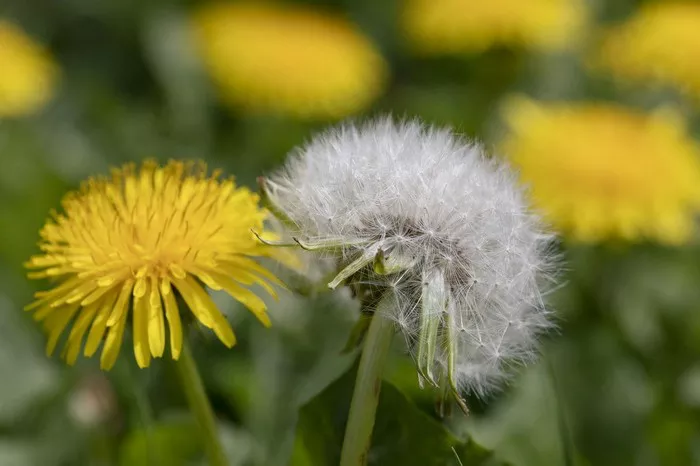Dandelions are one of the most well-known and easily recognizable flowers worldwide. Often considered a weed by gardeners, these bright yellow flowers have a fascinating history, diverse uses, and unique biological characteristics. In this article, we will explore various aspects of dandelions, from their botanical classification and lifecycle to their ecological importance and cultural significance.
Botanical Classification of Dandelions
Dandelions belong to the genus Taraxacum, which is part of the Asteraceae family. The most common species is Taraxacum officinale. This family, also known as the sunflower or daisy family, is one of the largest families of flowering plants, comprising over 23,000 species.
1. Genus and Species
- Genus: Taraxacum
- Species: Taraxacum officinale
The genus name, Taraxacum, is derived from the Greek words “taraxos” (disorder) and “akos” (remedy), indicating its historical use in medicine.
2. Family: Asteraceae
The Asteraceae family is characterized by composite flowers made up of numerous small florets arranged in a head (capitulum). Each “petal” of a dandelion flower is actually a single floret, and the center of the flower head consists of many tightly packed disc florets.
Physical Characteristics of Dandelions
1. Leaves and Roots
Dandelion leaves are long, deeply lobed, and grow in a rosette pattern close to the ground. These leaves are edible and have a slightly bitter taste. The roots are thick, deep taproots that can penetrate hard soils, making them difficult to eradicate.
2. Flowers
Dandelion flowers are bright yellow and are composed of numerous ray florets. Each floret is capable of producing a seed. The flowers close at night and open in the morning, following the sun throughout the day (a phenomenon known as heliotropism).
3. Seeds
The seeds of the dandelion are contained in a structure known as a pappus, which is attached to a slender stalk. When mature, the flower heads turn into a white, fluffy seed head that can disperse seeds over long distances with the help of the wind.
Lifecycle of a Dandelion
1. Germination and Growth
Dandelion seeds germinate quickly, often within a few days of landing on suitable soil. The young plants grow rapidly, developing their characteristic rosette of leaves.
2. Flowering and Seed Production
Dandelions can flower multiple times in a season. Each flower head produces hundreds of seeds, which are dispersed by the wind. This high reproductive rate allows dandelions to colonize new areas rapidly.
3. Perennial Nature
Dandelions are perennials, meaning they live for more than two years. Their deep taproots allow them to survive adverse conditions, such as drought or frost, and regrow each spring.
Ecological Importance of Dandelions
1. Pollinators
Dandelions are an important early source of nectar and pollen for bees and other pollinators. Their flowers bloom early in the spring, providing food when few other plants are in flower.
2. Soil Health
The deep taproots of dandelions help to aerate the soil and bring up nutrients from deeper layers, which can benefit other plants. They also help to prevent soil erosion.
3. Food for Wildlife
Dandelions are a valuable food source for various wildlife. Birds eat the seeds, while mammals such as rabbits and deer consume the leaves.
SEE ALSO: Preserving Dandelion Flowers: A Comprehensive Guide
Cultural and Historical Significance
1. Medicinal Uses
Dandelions have been used in traditional medicine for centuries. They are known for their diuretic properties, hence the French name “pissenlit,” which means “wet the bed.” Dandelion roots and leaves have been used to treat liver and kidney disorders, digestive problems, and skin conditions.
2. Culinary Uses
Dandelions are edible and nutritious. The leaves can be used in salads, soups, and teas. The flowers can be used to make dandelion wine, and the roots can be roasted and used as a coffee substitute.
3. Symbolism
In many cultures, dandelions symbolize resilience and perseverance due to their ability to thrive in challenging conditions. They are also associated with wishes and dreams, as children often blow the fluffy seed heads while making a wish.
4. Controlling Dandelions
While dandelions have many benefits, they are often considered a nuisance in lawns and gardens. Their ability to spread rapidly and their deep roots make them difficult to control.
5. Mechanical Control
Pulling dandelions by hand is effective but labor-intensive. It is important to remove the entire root to prevent regrowth.
6. Chemical Control
Herbicides can be used to control dandelions, but they should be used with caution to avoid harming beneficial plants and pollinators.
7. Natural Control
Maintaining a healthy lawn with dense grass can help to suppress dandelion growth. Mulching garden beds can also prevent dandelion seeds from germinating.
Interesting Facts about Dandelions
1. Adaptability
Dandelions can grow in a wide range of environments, from lawns and gardens to cracks in sidewalks and roadsides. Their seeds can remain viable in the soil for many years, allowing them to regrow even after long periods of dormancy.
2. Longevity
Dandelions can live for many years, with some plants known to survive for over a decade. Their perennial nature and robust root system contribute to their longevity.
3. Genetic Diversity
Dandelions are highly genetically diverse, with many different species and subspecies. This diversity helps them to adapt to different environments and resist diseases.
Conclusion
Dandelions are much more than just a common weed. They are a fascinating and versatile flower with a rich history and many uses. From their role in ecosystems as early pollinator plants to their use in traditional medicine and cuisine, dandelions have earned a place of respect in both nature and human culture. Their resilience and adaptability make them a symbol of perseverance and hope, reminding us of the beauty and potential in even the most overlooked plants.


